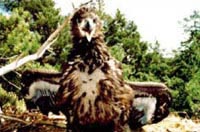


For 10 days following the April 26 explosion, the ruptured Chernobyl reactor continued to release major quantities of radioactive substances, amounting to a total of about 14 EBq. The most significant radioisotopes released were iodine-131, caesium-137, strontium-90 and plutonium radioisotopes (see table on radioisotopes released).
More than 200 000 km2 of Europe were contaminated above the level of 37 kBq/m2 of caesium-137 1 . Over 70 % of this area lies in the three most affected countries, Belarus, Russia and Ukraine though the radioactive material was distributed unevenly. For example, radioactive deposits were larger in areas where it was raining when the contaminated air masses passed. Also, because radioactive strontium and plutonium particles are heavier than many other radioactive particles, they were deposited within 100 km of the destroyed reactor.
The half-life of radioactive material is the time taken for half the amount initially present to decay. Because many of the most significant radioisotopes have short half-lives in the range of hours or days, most have decayed away by now. For the decades to come, the most important pollutant will be caesium-137 followed by strontium-90. Plutonium and its decay products (in particular americium-241) will remain in the environment over a longer term of hundreds to thousands of years though at low levels (see half-lives of radioisotopes emitted during the Chernobyl accident). More...

Substantial amounts of radioactive materials were deposited in the urban areas near the power plant. However, their residents were evacuated quickly so that they avoided being exposed to high levels of external radiation. Other urban areas have received different levels of deposition, and their residents have received, and are still receiving, some amount of external radiation.
After the accident, radioactive materials were deposited mostly on open surfaces such as lawns, parks, roads, and building roofs, for instance by contaminated rain. Since then, the surface contamination in urban areas has decreased because of the effects of wind, rain, traffic, street washing and cleanup. However, this has caused the secondary contamination of sewage systems and sludge storage.
Levels of radiation measured in the air in most urban areas are now the same as before the accident, except above undisturbed soil in gardens and parks in some settlements of Belarus, Russia, and Ukraine where they remain higher. More...
After the accident, the deposition of radioactive iodine contaminated agricultural plants, grazing animals, and thus the milk produced in parts of Belarus, Russia, Ukraine and some other parts of Europe. This direct deposition on plants was of most concern during the first two months after the accident since radioactive iodine decays quickly.
After this early phase of deposition, an increasingly important concern was plant contamination through absorption of radioactive materials, such as caesium and strontium, from the soil through their roots.
During the first few years after the accident, the levels of radioactive materials in agricultural plants and animals decreased quickly because of factors such as weathering and decay. In the past decade, the radioactivity levels have still gone down, but much more slowly.
Today, the levels of caesium-137 in agricultural food products from Chernobyl-affected areas are generally below national and international action levels.
However, problems persist in some rural areas of the former Soviet Union with small private farms where dairy cows are grazing in pastures that are neither ploughed nor fertilized. In addition, the milk produced in some parts of Belarus, Russia and Ukraine may still have high levels of caesium-137.
For decades to come, most of the radioactive materials that people take in through food and drink in the affected areas will be caesium-137 present in milk, meat, and crops. More...
Because radioactive caesium is continuously taken up and passed on by organisms in forest ecosystems, the animals and vegetation in affected forests and mountains are particularly contaminated. Forest food products such as mushrooms, berries and game contain the highest recorded levels of caesium-137.
While people are getting progressively smaller amounts of radiation from agricultural products, the doses they receive from forest products are expected to remain high for decades to come, since the decrease in the level of radiocaesium will be very slow.
The high transfer of radioactive caesium from lichen to reindeer and from reindeer meat to humans has been demonstrated after the Chernobyl accident in the Arctic and sub-Arctic areas of Europe. The accident led to high contamination of reindeer meat in Finland, Norway, Russia and Sweden and caused significant problems for the indigenous Sami people. More...
Radioactive materials from Chernobyl deposited on rivers, lakes and some water reservoirs both in areas close to the reactor site and in other parts of Europe. The amount of radioactive materials present in water bodies decreased rapidly during the first weeks after the initial deposition because the radioactive materials decayed, were diluted or were absorbed by the surrounding soils.
Fish absorbed radioactive iodine very quickly but the levels decreased rapidly due to radioactive decay . Bioaccumulation of radioactive caesium along the aquatic food chain resulted in high concentrations in fish in some lakes as far away as Scandinavia and Germany. The levels of strontium-90 in fish did not lead to significant human exposure, particularly as it accumulates in bones rather than in edible parts.
Aquatic bodies are still being contaminated by runoff of long lived caesium-137 and strontium-90 released from contaminated soils. At present, the water and fish of rivers, open lakes and reservoirs have low levels of caesium-137 and strontium-90. However, in some “closed” lakes with no outflowing streams in Belarus, Russia and Ukraine both water and fish will remain contaminated with caesium-137 for decades to come.
Contamination levels of the Black and Baltic seas were much lower than those in fresh water because of greater dilution and distance from Chernobyl. More...
The radioactive materials released by the accident had many immediate harmful effects on plants and animals living within 20 to 30 km of the Chernobyl power plant at the time of the accident. However, there are no reports of any such radiation-induced effects in plants and animals outside this area, referred to as the Exclusion Zone. Each plant and animal responded differently to the accident depending on the dose of radiation received and sensitivity to radiation.

Overall, in plants and animals, when high doses were sustained at relatively close distances from the reactor, there was an increase in mortality and a decrease in reproduction. During the first few years after the accident, plants and animals of the Exclusion Zone showed many genetic effects of radiation. Still today there are reports of anomalies in plants and animals both in the Exclusion Zone and beyond.
Over the years, as the radioactivity levels decrease, the biological populations have been recovering from acute radiation effects . Following the initial reductions in numbers, some of the populations have recovered and grown because individuals reproduced or because plants and animals migrated from less affected areas. The fact that human activities such as agriculture or industry have stopped, has helped this recovery. Paradoxically, the Exclusion Zone has become a unique sanctuary for biodiversity. More...

This summary is free and ad-free, as is all of our content. You can help us remain free and independant as well as to develop new ways to communicate science by becoming a Patron!